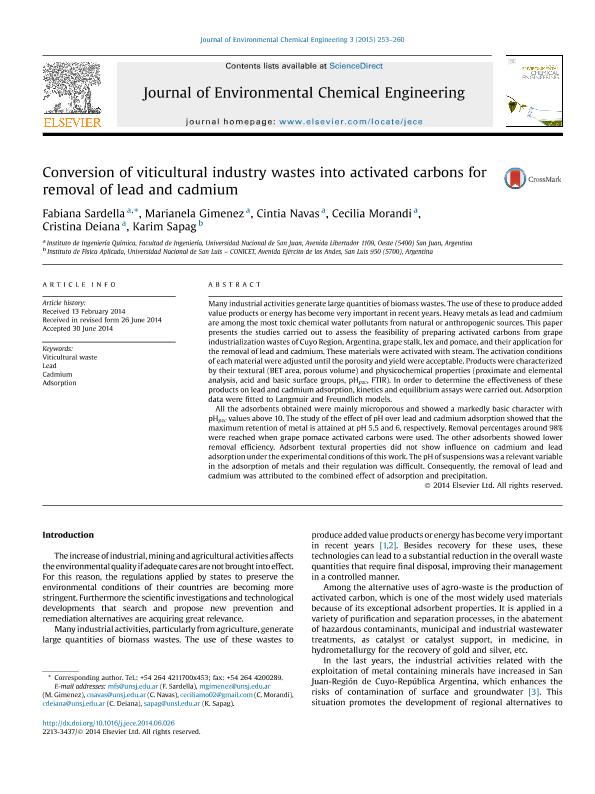Artículo
Conversion of viticultural industry wastes into activated carbons for removal of lead and cadmium
Sardella, Maria Fabiana ; Gimenez Guerrero, Marianela Gema
; Gimenez Guerrero, Marianela Gema ; Navas Echenique, Cintia Silvina
; Navas Echenique, Cintia Silvina ; Morandi, Cecilia; Deiana, Cristina; Sapag, Manuel Karim
; Morandi, Cecilia; Deiana, Cristina; Sapag, Manuel Karim
 ; Gimenez Guerrero, Marianela Gema
; Gimenez Guerrero, Marianela Gema ; Navas Echenique, Cintia Silvina
; Navas Echenique, Cintia Silvina ; Morandi, Cecilia; Deiana, Cristina; Sapag, Manuel Karim
; Morandi, Cecilia; Deiana, Cristina; Sapag, Manuel Karim
Fecha de publicación:
03/2014
Editorial:
Elsevier
Revista:
Journal of Environmental Chemical Engineering
ISSN:
2213-3437
Idioma:
Inglés
Tipo de recurso:
Artículo publicado
Clasificación temática:
Resumen
Many industrial activities generate large quantities of biomass wastes. The use of these to produce added value products or energy has become very important in recent years. Heavy metals as lead and cadmium are among the most toxic chemical water pollutants from natural or anthropogenic sources. This paper presents the studies carried out to assess the feasibility of preparing activated carbons from grape industrialization wastes of Cuyo Region, Argentina, grape stalk, lex and pomace, and their application for the removal of lead and cadmium. These materials were activated with steam. The activation conditions of each material were adjusted until the porosity and yield were acceptable. Products were characterized by their textural (BET area, porous volume) and physicochemical properties (proximate and elemental analysis, acid and basic surface groups, pHpzc, FTIR). In order to determine the effectiveness of these products on lead and cadmium adsorption, kinetics and equilibrium assays were carried out. Adsorption data were fitted to Langmuir and Freundlich models. All the adsorbents obtained were mainly microporous and showed a markedly basic character with pHpzc values above 10. The study of the effect of pH over lead and cadmium adsorption showed that the maximum retention of metal is attained at pH 5.5 and 6, respectively. Removal percentages around 98% were reached when grape pomace activated carbons were used. The other adsorbents showed lower removal efficiency. Adsorbent textural properties did not show influence on cadmium and lead adsorption under the experimental conditions of this work. The pH of suspensions was a relevant variable in the adsorption of metals and their regulation was difficult. Consequently, the removal of lead and cadmium was attributed to the combined effect of adsorption and precipitation.
Palabras clave:
Viticultural Waste
,
Lead
,
Cadmium
,
Adsorption
Archivos asociados
Licencia
Identificadores
Colecciones
Articulos(INFAP)
Articulos de INST. DE FISICA APLICADA "DR. JORGE ANDRES ZGRABLICH"
Articulos de INST. DE FISICA APLICADA "DR. JORGE ANDRES ZGRABLICH"
Citación
Sardella, Maria Fabiana; Gimenez Guerrero, Marianela Gema; Navas Echenique, Cintia Silvina; Morandi, Cecilia; Deiana, Cristina; et al.; Conversion of viticultural industry wastes into activated carbons for removal of lead and cadmium; Elsevier; Journal of Environmental Chemical Engineering; 3; 1; 3-2014; 253-260
Compartir
Altmétricas



